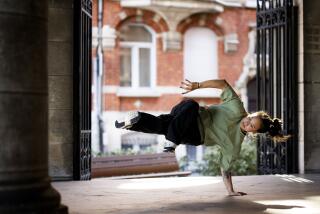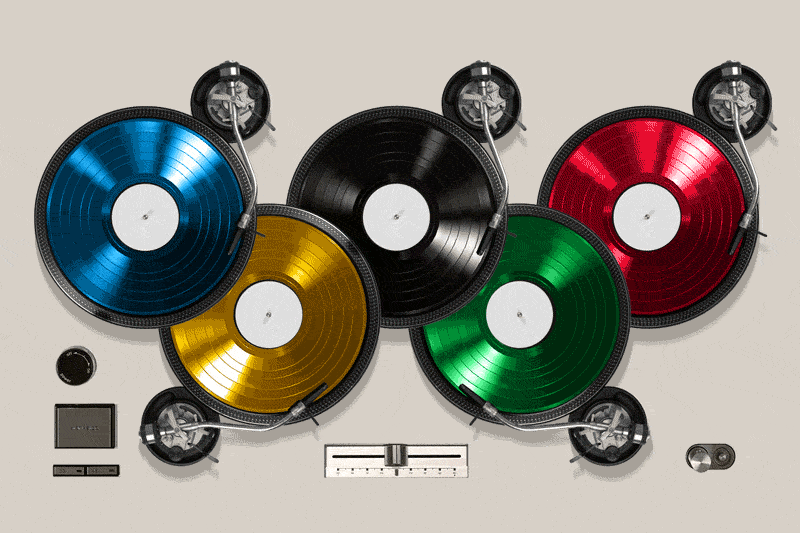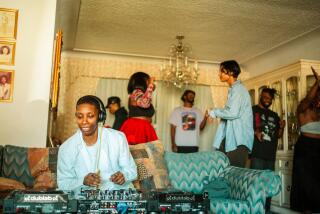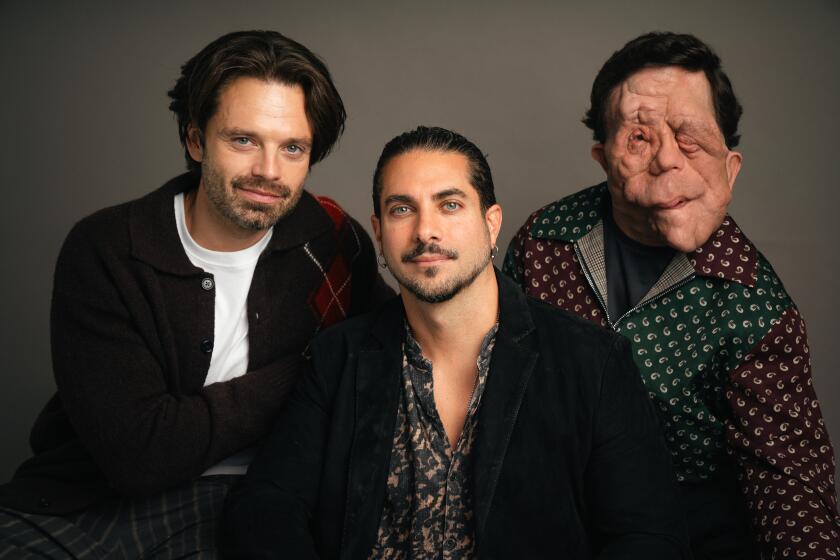With ‘The Breaks,’ VH1 revisits the ‘90s hip-hop scene when success wasn’t a sure bet
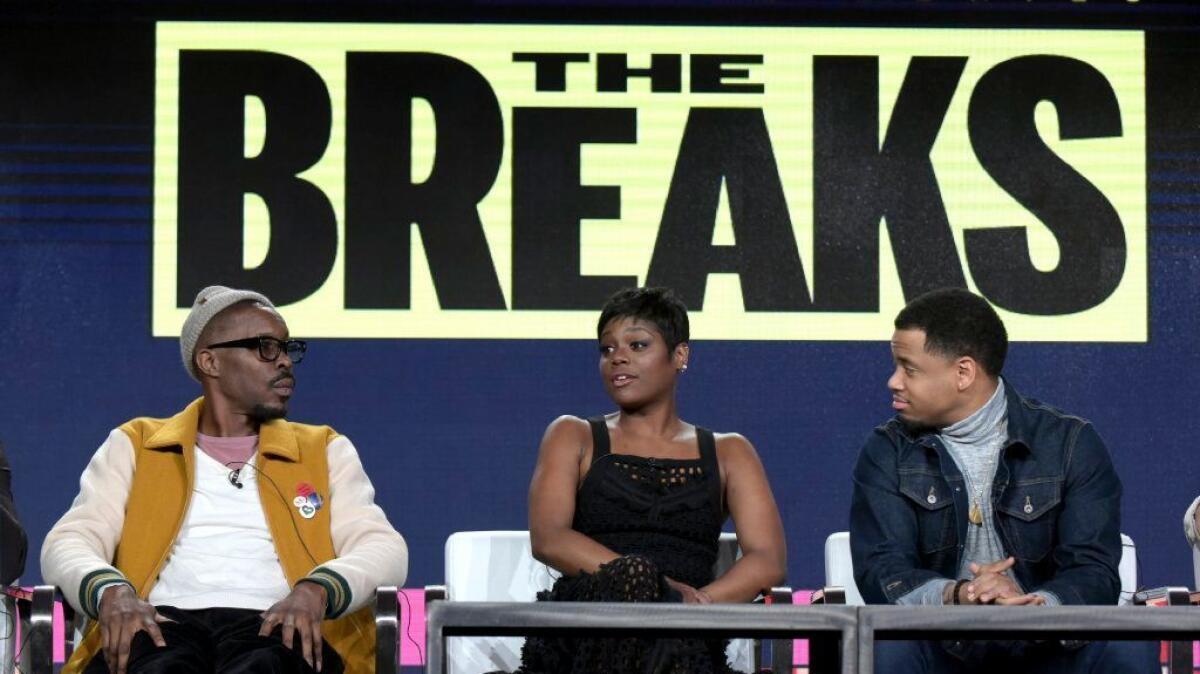
Reporting from NEW YORK — Outside, the world is abuzz about Donald Trump’s presidency and the latest Kanye controversy. But inside this downtown New York building, the clock has been turned back to the early days of hip-hop.
Cameras are rolling on the set of the new VH1 series “The Breaks,” as a miffed music manager has burst into the offices of the Village Voice.
“It’s not the sort of thing you do,” the manager, Nikki, fumes to a reporter.
“I’m not you, Nikki, I’m a journalist. The truth is non-negotiable,” the music writer fires back.
A moment later, the episode’s director pumps her fist.
“Cut it, print it, kill it. You got it,” says Neema Barnette. Then the director turns to a reporter to offer some finer context on the divisions in hip-hop at the time. “See, I’m a Harlem girl. Biggie, that’s Brooklyn. Jay Z. Well Jay Z is Jay Z.”
“The Breaks” is a time machine of sorts — and not just because of the outsized influence of the Village Voice. Chronicling an era when hip-hop’s role as a spark for both mass protest and mass commerce was just an ember, the eight-part series marks a new entry in scripted television’s growing rap canon. Where “Empire” dropped a soap opera into the contemporary hip-hop world and “The Get Down” examined a birth moment in the late 1970s, “The Breaks” splits the difference.
Set in New York in 1990, the show lands at the cusp of the golden age of hip-hop — a genre too new for anyone to know where it would go, but too promising (for some) not to believe that the destination would be somewhere significant.
“That period was very violent and very rough, but also very innocent in a lot of ways, especially the music,” says Seith Mann, a veteran director of shows such as “The Wire” and a co-creator of “The Breaks.” “And that’s what we want to capture in the show — how hip-hop grew from that innocence to a dominating business, how people in the arc of a season try to make choices so that they can make art.
“Some of them,” he adds dryly, “won’t stay innocent.”
Picking up where a 2016 VH1 original movie left off, “The Breaks” follows the interlocking lives of a group of people with various roles in the burgeoning sphere. There’s a trio of strivers that includes a wannabe producer, Deevee (Mack Wilds), the management acolyte Nikki (Afton Williamson) and a rookie radio-station programmer David (David Call). They cross paths with voluble mini-mogul Barry (Wood Harris), a talented but gang-affiliated MC (Antoine Harris, no relation to Wood) and the thirsty reporter, Damita (Melonie Diaz).
Inspired by Dan Charnas’ acclaimed nonfiction history “The Big Payback” (Mann’s fellow co-creator), “The Breaks” includes among its executive producers John J. Strauss, an executive producer on “Mozart in the Jungle,” another show about dogs eating dogs in a musical subculture.
As with that Amazon Prime video series, the multiple plot lines of “The Breaks” nearly all involve characters desperately seeking to carve out their place in a world — Nikki trying to establish herself in Barry’s company, Damita looking to be the genre’s go-to chronicler — whose animating principle remains more passion than money (though the latter is not entirely absent).
“The Breaks” is set a few years before artists such as A Tribe Called Quest, Nas, De La Soul and Wu-Tang Clan began flexing their cultural influence and solidifying hip-hop’s East Coast movement.
“I think there’s something really romantic about it; it just seems like a more dreamy era,” says Wood Harris during a break in shooting. “It felt like a time anyone could be a mogul — and with a beeper, which if you tell a young person about now, they will laugh,” he says, chuckling as he gestures to a prop on his belt. “Or think it’s something that only exists on YouTube.”
That’s hardly the only playful affect: “The Breaks” brings the dorkily endearing names of the era (“Chuck Chillout”) as well as the baggy and colorful fashions. There’s also another kind of wink-y appeal to “The Breaks.” Much of the show plays on the audience’s familiarity with how much rap blew up. In the second episode, when Deevee argues with his hospital-worker father — who wants to send Deevee to South Carolina because he doesn’t think his son is involved in a real business — the audience can nod knowingly at the younger man’s insistence on hip-hop’s bright future.
Still, the creators say they’re intent on driving home how precarious a moment it was for the genre.
“It wasn’t inevitable that hip-hop would become as massively popular as it did,” Mann says. “Hip-hop in those early days was dicey — it could have gone the way of disco and go-go.”
Nor was it clear who would document its ascent. Though hip-hop journalism at the time had a heavily male component, producers tip their Snapbacks to pioneers like Raquel Cepeda and dream hampton. “I think what surprised me is how much women were involved in covering it and bringing the news to the wider world,” Diaz says. “It’s just not something you hear about a lot.”
Those looking for a heavy original musical component to the show may be only partly satisfied. While bits of new songs, written by former Little Brother member Phonte Coleman and produced by DJ Premier, are heard, the creators chose to focus more on dialogue and character than beats.
Overt references to real-life figures also are somewhat scant, though tracks from Public Enemy, already well-established by 1990, are present, as are fictional portrayals of new jack swing artists like Keith Sweat. (This fictionalization is by design, say Seith and Charnas, giving them freedom to create without becoming caught in a tangle of rights and legal action.)
Charnas says he actually pitched the series to Fox as far back as 2010, long before “Empire,” and was met with indifference and even confusion. He soon landed at the show’s current venue.
“Everyone at VH1 got it right away,” says the author, who often serves a truth-checking role on set that has led colleagues to dub him “the Treasurer of the authenticity bank account.”
“The Breaks” makes a lot of sense for the network, said Chris McCarthy, president of MTV, VH1 and Logo. “VH1 has always been comfortable both with looking back and celebrating the present. So, hip-hop in the ’90s is a very natural place to be.”
In recent years, the network has developed a programming slate that draws a large female African American audience, including reality franchises such as “Love & Hip-Hop” and “Basketball Wives.” But scripted is a more expensive undertaking, and if the appeal for a hip-hop show stretches into broader demographics, the accompanying risk grows too.
Also debatable is whether television’s hip-hop era has reached its saturation point.
After a breakout first season, “Empire” fell off a cliff both in the ratings and, to many observers, creatively, while “The Get-Down” made a comparatively small splash in Netflix’s zeitgeist pool. Hip-hop may now be such a cultural given that the idea of how it emerged is only of modest interest.
Creators of “The Breaks” say anyone taking that view is making a mistake.
“I don’t think Obama is president without hip-hop — it brought so much into the mainstream,” says Charnas, who underscored that connection in “The Big Payback.”
“What’s interesting about the time — and hopefully the show — is the unwitting heroes in hip-hop. A lot of people who weren’t setting out to change the world were the ones who did.”
‘The Breaks’
Where: VH1
When: 9 p.m. Monday
Rating: TV-14 (may be unsuitable for children under the age of 14)
See the most-read stories in Entertainment this hour »
Twitter: @ZeitchikLAT
More to Read
Only good movies
Get the Indie Focus newsletter, Mark Olsen's weekly guide to the world of cinema.
You may occasionally receive promotional content from the Los Angeles Times.
